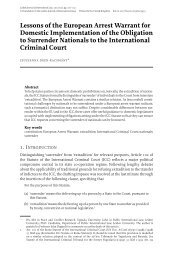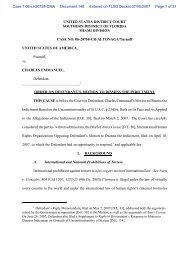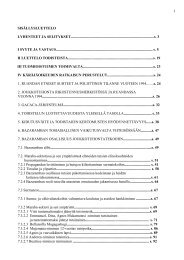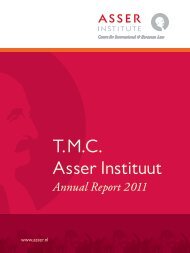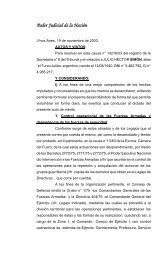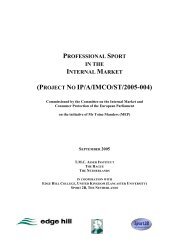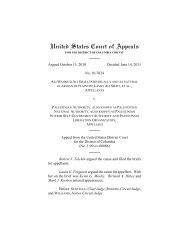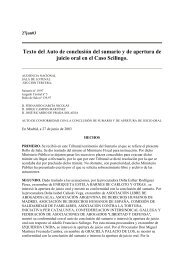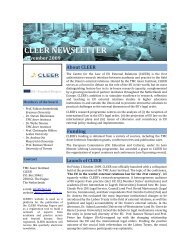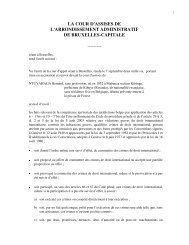Islj 2009 3-4 - TMC Asser Instituut
Islj 2009 3-4 - TMC Asser Instituut
Islj 2009 3-4 - TMC Asser Instituut
Create successful ePaper yourself
Turn your PDF publications into a flip-book with our unique Google optimized e-Paper software.
tions. There are two important features of athletes, which encourages<br />
athletes to hire sports agents for investment advice and income management.<br />
Firstly, the length of the career of an athlete is overall quite<br />
short, compared with a normal career. Secondly, many athletes are<br />
paid very well. For an athlete, it is not easy to make good decisions<br />
about investments, because they do not have the knowledge. Income<br />
management is needed, because most of the athletes find it difficult<br />
budgeting their expenses over their whole life course. Many athletes<br />
become very rich on a young age and they are not always aware of all<br />
the different expenses. Since the third function is different from the<br />
first two, it might be performed by a specialist.<br />
The fourth function of sports agent is legal and tax counseling,<br />
because the above functions have several legal and tax implications. It<br />
makes sense, if the third and fourth function is performed by different<br />
specialists.<br />
Nowadays, another function can be added to the list, because athletes<br />
sign deals with sports agents at a younger age. This means that<br />
the sports agent is concerned about the education, health and progress<br />
of the youth player under contract. The fifth function will lead to an<br />
increase in monitoring by the sports agent. In this way, the relation<br />
between the sports agent and the athlete will be more intensive.<br />
Sometimes it is even called as ‘babysitting’ by sports agents (Shrop -<br />
shire & Davis, 2008)<br />
2.1.2. Conclusion<br />
In this study we will focus on the sports agents who perform all the<br />
functions for the player. Sports agents, who perform the five functions,<br />
are the greater players in the market of sports agents and they<br />
have a clear vision and goal as a sports agent. The third and fourth<br />
functions can be outsourced to specialists. These companies of sports<br />
agents are not those, who are looking for fast deals and money.<br />
The first two functions of sports agents are the main reasons why<br />
the market for sports agents exists.<br />
For simplicity, it will be assumed that every athlete has one sports<br />
agent who is negotiating the contract. So, a sports agent is the representative<br />
of an athlete who negotiates on his behalf with the club to<br />
bargain the best possible contract.<br />
2.2. Labor market for players<br />
In order to clarify what the role is of sports agents, it is necessary to<br />
illustrate how the labor market for players works. Due to inefficiencies<br />
in this market, there is a need for sports agents in the bargaining<br />
process between the athletes and clubs. In this paragraph, the labor<br />
market for players will be explained and it shall be pointed out where<br />
the sports agents come in.<br />
The fans of professional sports and the media are astonished, when<br />
they hear about the salaries of several star athletes in different kinds of<br />
sports. Whenever a football player, baseball star or race driver signs a<br />
multi-year contract for several millions euro’s a year, the public is<br />
thinking: why are these people earning such amounts of money?<br />
Economists immediately recognize scarcity rents, because the supply<br />
of star athletes consists of a few athletes. It automatically means that<br />
the athletes have a powerful position in the bargaining process, which<br />
results in the high salaries nowadays (Rosen & Sanderson, 2001). If<br />
there are no scarcity rents, the wage would be driven down to the<br />
opportunity costs of the athlete, which was the case before the free<br />
agency (Quirk & Fort, 1999). The labor market for athletes has some<br />
important elements, which are also present in normal labor markets.<br />
For economists, the labor market for athletes is an interesting field for<br />
applied economics, because there is a lot of information available of<br />
the workers (athletes) and their production (goals, home runs, assists<br />
and more) is known. It makes it easier to estimate the marginal product<br />
of player, which is usually not possible for the normal labor market.<br />
Still, there are some difficulties for clubs to determine the wage<br />
of a player. In a perfect world, player salaries would reflect the value<br />
of athletes to their teams. The high demand to professional sports is<br />
leading to the high salaries of the athletes (Quirk & Fort, 1999).<br />
In the economic discussion of the labor market in professional<br />
sports, some aspects dominate in most academic literature. These topics<br />
are: demand for labor, monopsonistic market and the winner’s<br />
curse.<br />
For convenience, the topics will be discussed in turn.<br />
2.2.1. Demand of labor<br />
The demand for labor is derived from the demand curve for the ultimate<br />
goods and services, where the labor is used as an input.<br />
Economics uses the marginal product of labor to determine, what a<br />
specific worker has contributed to the service or good. The theory of<br />
the marginal productivity theory relies on the assumption of profit<br />
maximizing. This assumption is the basis of the model, because more<br />
labor is employed up to the point that the last unit of labor adds as<br />
much revenue to the firm as it costs the firm. So, the marginal product<br />
of labor must equal the marginal cost of labor. If the last unit of<br />
labor costs more to a firm than it brings in additional revenue, then a<br />
firm would not hire the last unit of labor (Sandy, Sloane & Rosen -<br />
traub, 2004).<br />
One of the unique aspects of the labor market for athletes is the fact<br />
that personal contributions are easily to observe. The marginal product<br />
of a player can easily be assessed and this is an important input for<br />
team owners to set the wage for a player. A lot of data is available on<br />
the personal achievements of the players in games. By setting the<br />
wages of players, the demand for the professional sport is also important,<br />
as explained above. When the demand for the professional sport<br />
increases, the athletes can expect to receive higher salaries. The competitive<br />
balance measures the attractiveness of a certain competition.<br />
With a higher competitive balance, costumers are willing to pay more<br />
for the services (Groot, 2008, pp. 25-27).<br />
‘If general managers really were perfect judges of talent, there<br />
would be no need to play the league schedule to determine the<br />
league champion - we’d simply award the title to the one with the<br />
highest payroll.’ (Quirk & Fort, 1999, p. 85)<br />
This quote says that there are difficulties in determining the talent of<br />
athletes and subsequently the salary, because otherwise the salary<br />
would exactly match the marginal product of labor. There are two<br />
important difficulties in determining the marginal product. The first<br />
difficulty is the presence of interdependence of athletes in team sports.<br />
It is important that the players cooperate with each other and that<br />
they make each other better, by knowing each other’s weaknesses and<br />
strengths (Sandy et al., 2004). This makes it difficult to know the<br />
marginal product of labor of one player of the team, because he could<br />
be good in cooperating with other athletes. Secondly, clubs have<br />
uncertainty over the future marginal product of labor of an athlete.<br />
They could be injured or the skills can deteriorate or improve and<br />
with a rookie the clubs do not know what to expect from these athletes.<br />
The uncertainty of the future of a player makes it hard for club<br />
to set the right wage for an athlete. The stats of an athlete are not providing<br />
a certain marginal product of labor for the next season.<br />
For a club, there are also high training costs in order to raise a<br />
potential good player. The training a player receives is useful for every<br />
club in the same sport. This leads to the chance that the player goes<br />
to another club and the club who invested in the player does not<br />
receive compensation. That is an economic rationale for long contracts,<br />
because clubs need incentives to invest in their players. Clubs<br />
also have difficulties to monitor their young players. It is hard for a<br />
club, to monitor a young player outside the training field, if they do<br />
so there are high costs involved.<br />
Summarizing, the clubs face difficulties in the labor market<br />
through the degree of uncertainty of future productivity, the high<br />
training and monitoring costs and the high sensitivity of productivity<br />
to cooperation between players within one team. In the next chapter,<br />
the power of the clubs will be discussed (Sandy et al., 2004).<br />
2.2.2. Monopsonistic market<br />
The number of clubs at the highest level in a particular sport is small<br />
and may form an interconnected group, which has the danger to lead<br />
to some kind of power. In this case, it will lead to monopsonistic<br />
power in the labor market of athletes. The result is that the athletes<br />
A RT I C L E S<br />
<strong>2009</strong>/3-4 75




